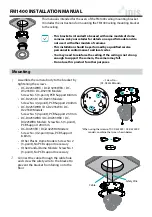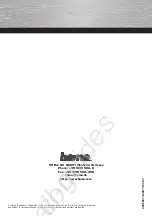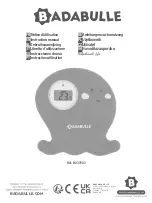
You will notice that moving the speakers just 6mm (
1
⁄
4
”) away from the ears or out of alignment can easily
halve the volume and reduce the sound quality by letting in considerable external background noise, which
will spoil the full potential of sound quality and performance, especially at higher speeds when out on the
bike and the helmet noise becomes far more powerful. Correct speaker positioning is therefore essential
and you will hear this during this test. It is also beneficial to speak through the system so that you get a
measure for the speech quality and level when the speaker are correctly positioned, but in order to do this
you first need to find, understand and use the microphone loud spot.
While speaking into the
beige side
of the microphone gently move it about while just touching your lips
and project your voice through it, positively as if to someone 15 feet away (5 metres). You will discover a
LOUD SPOT
which produces the maximum sound level. Note; how just a few millimetres (
1
⁄
8
”) movement
can greatly affect the level of speech.
If you do not use the loud spot correctly the level of your voice will be greatly reduced and so other users
will struggle to hear you at high speeds, especially when using high attenuation earplugs. It is therefore
essential that you learn about and use this important loud spot as the system is tuned to it. You should not
turn the volume controls up to compensate for not using this loud spot correctly as it will amplify more
noise through the system than if you use the loud spot properly and turn the volume down.
Listen to speech carefully and try to remember the audio levels, because after installation in your helmet/s
you need to assess if the sound level and quality are as good as before, because if not you need to fine
tune the speaker and/or microphone positioning until it is. Please use the same radio through the system
and same level of exterior noise during both pre-installation and after installation tests.
Top Tips
This may seem a strange way of evaluating and setting up the system but it really works and although your first
helmet may take a little longer you will get it right and then all further headset installations should be much
easier and quicker due to getting through this important learning curve. Do both the pre-installation test and the
final test after helmet installation without earplugs so that you can hear the vast difference it makes in having
your microphone and speakers positioned correctly. If you try this while using earplugs they will disguise much
of what you are trying to hear, understand and achieve.
Avoid pressure directly to the front and back
covers of the microphones as this could cause damage
. The microphone is floating in an acoustically
dampening material to help prevent any helmet vibration being transmitted through the boom to the microphone
as part of the noise cancelling measures. To move or adjust the microphone please hold it by the outer edges
or rubber neck, making sure that the beige side of the fabric sits flat against and central to your lips.
MICROPHONE LOUD SPOT
The Autocom helmet headset that is designed for the bike-to-bike kits come in two parts
1
Main headset loom with built-in speakers (
Part 2083
)
2
Plug-in boom microphone (
Part 2074
) .
These headsets are not designed to work with
1
⁄
2
helmets (Chip style)
There are too many different helmets to be able to fully describe every possible installation and so these
instructions are designed as a basic guide. Please note that helmets with straps that go directly over your
ears do not lend themselves for a good headset installation because the speakers have to sit on top or
behind the straps. This can make them uncomfortable or reduce sound quality. Some helmets do not lend
themselves to be installed and may require alternative methods, so please take some time to consider
these basic principles and your helmet design before installation. If you are unsure then please contact
your supplier or Autocom. If your system is not performing as we claim, it is almost certainly due to
incorrect installation and/or use.
Main headset loom
(
Part 2083
)
This is a twin speaker, stereo headset loom with a short down lead fitted with our 7-pin din plug, for
connecting to our systems. It has a small red socket for plugging in a choice of boom microphones.
Before installing your headset you must first listen to it by plugging it into your system, then while holding
the speakers directly over your ears, get someone to speak to you through the system. Doing this is very
important to help you to understand what to expect when the speakers are positioned correctly. Moving
the speaker’s just 5mm (
1
⁄
4
") away from the ears, or out of alignment can easily halve the volume and/or
reduce the bass, especially when out on the bike when the powerful helmet noise can overwhelm the
speaker sound. Correct speaker positioning is essential and you will hear this during this test. Use earplugs
during this test if you intend to use them out on the bike, bearing in mind that over attenuating earplugs
will impair speaker sound.
Please study the helmet illustrations to get the general idea for installing the headset into your helmet.
Also note the illustrations on pages 5 and 6, which show correct speaker and microphone positioning.
If required, tape the rubber joint and/or boom to the outer shell or inner lining so that they are secure.
Position the speakers for maximum comfort and performance, then tuck the speaker wires into or behind
the lining. The small red connector is for plugging in one of our boom microphones. You may find that you
need to reposition the speakers, about once a year, due to slight movement that can happen when taking
the helmet on and off your head.
Top tips
You may need to fine-tune the speakers positioning several times before finding the optimum position for
comfort and performance. Start with the speaker’s low, so as to avoid pressure to the top of the ear and
slowly move them up until you find the optimum position. Try to position the speakers behind the helmet
fabric if possible (on top of the polystyrene). Pack the speakers out to your ears with foam if required. A
slight angle out towards the top edge of the speakers (as shown on page 6) can help with comfort and
performance. Normally the speaker wire will come out facing the back of the helmet.
HEADSET INSTALLATION
You must speak into the beige side of the microphone
The microphone must be
just touching the lips
5
4






















